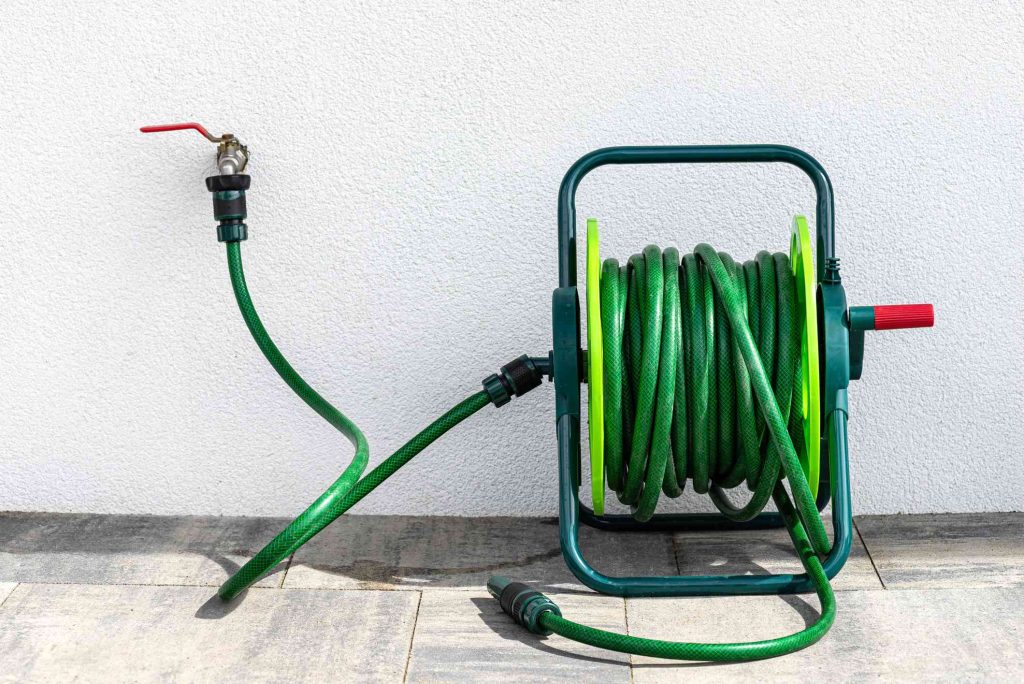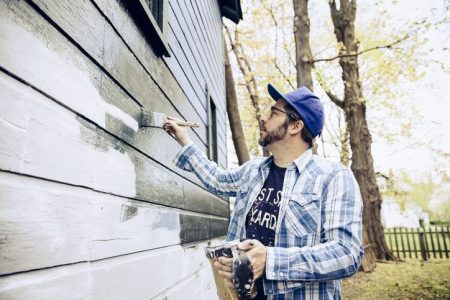Connecting a garden hose to the faucet should be fast and easy, but it often isn’t. Threading a garden hose to a faucet takes up time when gardening and wears down the threads a bit more each time.
With garden hose quick connectors, you can push the hose straight into the faucet instead of threading it on. Made of either metal or plastic, these fittings disconnect with equal ease by pulling back on the retractable collar. Quick connectors extend the life of hose and faucet threads by preserving delicate brass threads.
Brass vs. Plastic Hose Quick Connectors
| Brass Quick Connectors | Plastic Quick Connectors |
| Last for many years | Last one to two years |
| Heavy | Lightweight |
| Slimmer | Bulkier |
| No UV deterioration | Deteriorate in sunlight |
| More expensive | Less expensive |
Brass hose quick connectors last long and resist cracking. Plastic quick connectors should be replaced every year or two. Brass hose connectors are slightly smaller and heavier than plastic quick hose connectors. Brass quick connectors cost about twice as much as plastic connectors.
What You’ll Need
Equipment / Tools
- Utility knife or tube cutter
Materials
- Garden hose quick connector
- Lever flow-thru valve
Instructions
Connecting a Garden Hose With a Permanent Quick Connector
One type of garden hose quick connector attaches permanently to the hose. This quick connector installs in about five to ten minutes per hose and requires you to cut off the hose’s threaded female end. Unlike threaded hose quick connectors, this type won’t loosen when the hose twists.
-
Cut Off the Female Hose End
Drain the garden hose. With a sharp utility knife, cut off the female end of the garden hose. Choose a spot about one to two inches past the end fitting. Cut the hose squarely, not at an angle.
-
Remove Burrs From the Hose
Carefully pare away burrs and stray pieces of hose produced by the cut.
-
Clean the Hose
Wipe off the end of the hose with a clean cloth.
-
Slip on the Compression Ring
Slide the compression ring on the hose, with the ring’s threads facing the end of the hose.
-
Fit on the Faucet End Connector
Slide the faucet end connector onto the end of the faucet. If the connector won’t slide, try warming up the hose or daubing it with dish soap.
-
Secure the Faucet End Connector
Slip the compression ring up to the faucet end connector’s threads and screw it on by hand.
-
Attach the Faucet End Adapter to the Faucet
Screw the faucet end adapter to the end of the faucet by hand.
-
Attach or Detach the Hose
Push the hose connector firmly into the faucet connector. You may need to pull back on the retractable collar to attach the hose. Detach the garden hose from the faucet by holding the hose with one hand and pulling back on the retractable collar with the other hand.
You can now wind the garden hose into your hose reel to keep it organized.
Connecting a Garden Hose With a Threaded Quick Connector
One type of garden hose connector threads onto both the hose and the faucet. This type of connector is simple to install in just a few minutes, with no cutting required. While the hose-end connector can loosen over time with the twisting of the hose, it’s easy to manually twist tight again.
- Attach the faucet end adapter: Screw the faucet adapter to the end of the faucet and tighten it by hand.
- Attach the hose end adapter: Screw the hose end adapter to the end of the garden hose.
- Attach the hose to the faucet: Attach the hose to the faucet by pushing the hose end adapter firmly into the faucet adapter. If it does not easily connect, pull back on the hose end adapter’s retractable collar while pushing.
- Detach the hose from the faucet: Remove the garden hose from the faucet by holding the hose with one hand and pulling back on the hose end adapter’s retractable collar. Pull the hose straight out to remove it.
Connecting a Garden Hose With a Lever Flow-Thru Valve
A lever flow-thru valve connects a garden hose to the water supply with a female threaded coupler. The coupler’s large plastic or rubber ring is considerably easier to turn than a hose’s brass ring. The cut-off lever shuts off the water flow faster than turning the faucet handle.
- Attach the valve to the hose: Attach the flow-thru valve to the female threads of the hose by turning the hose’s ring clockwise.
- Tighten the valve on the hose: Hold the valve with one hand and tighten the hose’s hex nut with a wrench to tighten it.
- Attach the hose to the faucet: Steady the hose with one hand and turn the flow-thru valve’s rubber ring clockwise to attach it to the faucet.
Tips for Using Garden Hose Quick Connectors
- Keep the connectors clean.
- Avoid resting connectors in garden beds or dirt.
- Avoid dragging connectors across concrete or other hard paving materials.
- Store the connectors in a warm, dry area in off-seasons or during long periods of disuse.
Troubleshooting Garden Hose Quick Connectors
- Water is leaking from the faucet connecter end: Grip the connector with a towel and turn it clockwise to tighten it. If that doesn’t work, remove the connector and replace the rubber ring.
- Water is leaking from the faucet but the connector is in good shape: The faucet’s threads may be stripped or counter-threaded. If so, replace the faucet bibb.
- Water is leaking from the female end of the hose: Replace the hose washer.
- Water is leaking under the faucet: The quick connector may not be seated properly. Pull the retractable collar back, remove the connector, and push it into place again.
- The nipple section of the hose end connector is leaking water: Buy a garden hose quick connector repair kit and replace the small O-ring.
-
Are all garden hose connectors the same?
Garden hose connectors are not all the same. One type of garden hose connector can be attached to both the faucet and the hose simply by screwing on the parts by hand. This connector type is easy to install but bulky and may loosen over time. With the second type of garden hose connector, the hose end adapter is permanently attached to the hose. This connector takes a little more time to install but it’s lighter weight and the chance of loosening is greatly reduced.
-
How does quick disconnect fitting work?
A quick disconnect fitting on a garden hose works by pulling back on the retractable collar. This releases the connection. Depending on the connector type, the collar may be on the hose or it might be on the faucet.
Read the full article here














